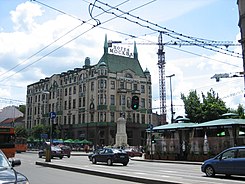Terazije
| Terazijski plato | |
|---|---|
| Place in Belgrade | |
 Hotel Moskva on the northern edge of the Terazije |
|
| Basic data | |
| place | Belgrade |
| District | Old town ( Stari Grad ) |
| Created | in the 19th century |
| Newly designed | 1911, around 1947 and after 1991 |
| Confluent streets | Knez Mihailova ulica , Kolarčeva, Bulevard Despota Stefana, Terazije, Nusiceva |
| Buildings | Monument to Prince Michael, National Museum, National Theater, Fountain |
| use | |
| User groups | Road traffic |
| Space design | New at the end of the 20th century |
| Technical specifications | |
| Square area | elongated |
The Terazije ( Serbian - Cyrillic Теразије ) is the main square of Belgrade , the capital of Serbia . It is located in the Stari Grad district . There is no clear separation between the broad Terazije (street) and the Platz der Republik ( Trg Republike ) to the north .
etymology
The term "terazije" comes from the Persian word for scales , but in Ottoman it also referred to structures for water distribution for the so-called water reservoirs, which were built in the form of towers. According to the historian Milan Đ. Milićević, the water storage towers terazije na vodu (water reservoirs) next to the Terazije, in front of today's Café Ruski Car and the Café Grčka kraljica. During the Turkish occupation of the city, the towers were used to balance the water level in the masonry pipes ( đelize ) from the drinking water sources in Mali mokri lug and Bulbuder ( Bulbuderski vodotok ) to the so-called Belgrade Schanze with the public fountains of Čukur-česma and Saka- česma . The largest of these towers stood on the site of today's Terazije Fountain in front of the Moskva Hotel. After this, the whole district and the square got its current name.
history
The Terazije is now the main square of the city of Belgrade and was once located in front of the Belgrade Schanze. There was a wide apron here, at the beginning of the 19th century only the city's landfill was found. Although the most important place in the Ottoman period was outside the fortified hill in front of the Stambol kapija (Istanbul Gate), today's Platz de Republik, Prince Miloš Obrenović chose the Terazije when expanding the city beyond the border of the hill. The first modern expansion of Belgrade began with the relocation of the smithy from the Schanze and settlement on the Terazije. Although the area in front of the Stambol kapije was more convenient in terms of traffic, Prince Miloš probably chose the Terazije because condemned and executed Serbs were publicly displayed in front of the Stambol kapija and this was therefore avoided by Christians. There was also a strong segregation between the Muslim and Christian residents of Belgrade. While the Serbs settled on the Sava side to the west of today's Vasa Ćarapića in the Sava mala district, the Danube-side quarters to the east of what was then Istanbul Street formed Muslim quarters.
Description and development on the edge
The approximately 250-meter-long (Bulevard) Terazije and the approximately 1500 m² square of the Republic are dominated by fountains, well-tended green areas and numerous well-known buildings. On the east side of the Republic Square is the equestrian monument for Prince Michael ( Knez Mihailov ), which the locals call The Horse . Behind it, facing north-south, are the National Museum and on the corner between Republic Square and Terazije the Hotel Moskva shown in the picture . The National Theater and the New Castle can be found on the south side of the Terazije . In a small park in front of the theater there is a bronze statue for the Serbian novelist Branislav Nušić (Бранислав Нушић). The New Palace houses the Belgrade city administration on the inside, while the seat of the Serbian President is in the northwest wing . Today's student club on the north side of the street was built in the 20th century as the Yugoslav Dramaturgical Theater and was an officer's club until 1968.
Before the destruction in World War II, the area adjacent to the north was called Pozorišni trg and formed a roundabout with Terazije, onto which six symmetrical streets led. In the center of the square was the obelisk-like fountain ( Terazijska česma ), with which Prince Miloš was honored.
Web links
- Description of the square on the website of the city of Belgrade (German)
- Historical views around the Terazije, between 1880 and the 1930s
Individual evidence
- ↑ Radio Beograd, Predvarošica Beograda - Terazije cultural broadcast Radio Belgrade: Stari Beograd V
- ^ History of Belgrade Public Fountains
- ↑ City homepage with explanations on the Terazije
- ^ Radio Beograd: Stari Beograd V
- ↑ Terazijski Plato on arhitekturabezbeograda.files.wordpress.com ( Memento of the original from March 16, 2016 in the Internet Archive ) Info: The archive link was inserted automatically and has not yet been checked. Please check the original and archive link according to the instructions and then remove this notice. ; Retrieved November 21, 2013
Coordinates: 44 ° 48 ′ 54 ″ N , 20 ° 27 ′ 36 ″ E